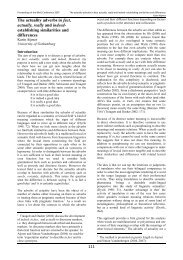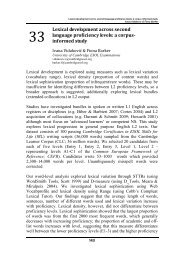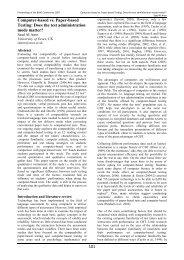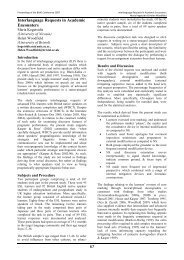Proceedings of the - British Association for Applied Linguistics
Proceedings of the - British Association for Applied Linguistics
Proceedings of the - British Association for Applied Linguistics
Create successful ePaper yourself
Turn your PDF publications into a flip-book with our unique Google optimized e-Paper software.
18<br />
Introduction<br />
Enterprise culture as Projected in Mission Statements <strong>of</strong> Educational Institutions: A Functional Perspective<br />
Hala T. S. Maklad<br />
Enterprise culture as Projected in Mission<br />
Statements <strong>of</strong> Educational Institutions: A<br />
Functional Perspective<br />
Hala T. S. Maklad<br />
Sadat Academy <strong>for</strong> Management Sciences<br />
The study aims at revealing <strong>the</strong> components <strong>of</strong> enterprise culture as<br />
reflected in mission statements, drawing upon systemic functional grammar<br />
(Halliday, 1994; Halliday & Matthiessen, 2004). Keat (1990: 4) defines<br />
enterprise culture as (a) <strong>the</strong> reconstruction <strong>of</strong> a wide range <strong>of</strong> institutions<br />
along business lines; and (b) <strong>the</strong> conduct <strong>of</strong> <strong>the</strong> individual, who should<br />
develop and exhibit ‘enterprising’ qualities, such as personal responsibility,<br />
independence, resourcefulness and self-discipline. Since a mission<br />
statement is primarily a reporting genre influenced by <strong>the</strong> colonization <strong>of</strong><br />
<strong>the</strong> promotional genre (Bhatia, 2004: 84), and “decidedly persuasive”<br />
(Williams, 2008: 100), it is assumed that <strong>the</strong> departure point <strong>for</strong> identifying<br />
enterprise culture components is <strong>the</strong> analysis <strong>of</strong> mission statements within<br />
<strong>the</strong> Ethos Model suggested by (Isaksson and Jørgensen, 2010) and built on<br />
Aristotle’s ethos concepts (Aristotle, 1932 cited in Williams, 2008:101).<br />
Method<br />
Twenty four Mission statements are collected from websites <strong>of</strong> Egyptian<br />
private and public universities, 12 from each. Each text is analyzed into<br />
clauses, finite and non finite, and each clause into its main constituents (a)<br />
Process Type, mainly Material and Relational; and (b) Participants: Actor<br />
and Goal/Beneficiary/Client. According to Process Types and Participants,<br />
each clause is coded as representing:<br />
(a) Appeals <strong>for</strong> communicating ethos <strong>of</strong> Expertise, Trustworthiness,<br />
and Empathy expressed respectively by <strong>the</strong> rhetorical strategies <strong>of</strong><br />
Self Promotion, Self Characterization, and Self-Sacrifice (Isaksson<br />
and Jørgensen, 2010: 230-1);<br />
(b) Enterprise culture components: (i) Commercial Enterprise, i.e. <strong>the</strong><br />
tendency to run <strong>the</strong> educational institutions as a commercial<br />
91







